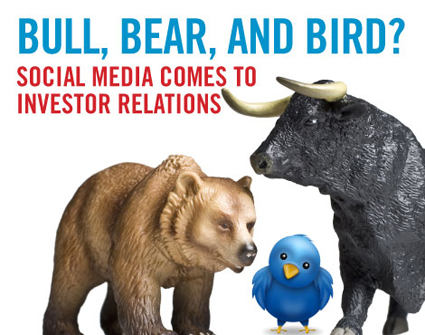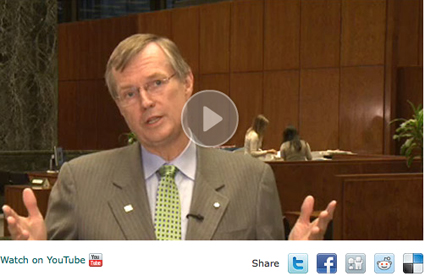Bull, bear, and bird: Social media and investor relations
Banks start using social media to reach out to shareholders
- |
- Written by David Hogan, director of investor relations, First Financial Bankshares

 |
When Renasant Corp., parent company of Mississippi-based Renasant Bank, announced its acquisition earlier this year of American Trust Bank of Roswell, Ga., it didn’t just send a news release. Renasant also posted the news on Twitter and Facebook.
Renasant, with $3.6 billion in assets, is one of the first publicly traded U.S. banks to use social media channels to communicate with shareholders and the investment community. Megabanks Citicorp and TD Bank are among other early adopters.
Perhaps reflecting their traditionally conservative stance, banks have been late to the party when it comes to embracing social media for investor relations purposes. Even old-line industrial companies such as Alcoa, the aluminum producer, are ahead of most banks when it comes to experimenting with innovative ways to share their investor news using the latest technology.
Some observers believe bank investor relations officers will jump aboard the social media bandwagon soon.
“We view social media’s role within investor relations as one that will only become more significant in the months and years ahead,” said Bradley Scott, product manager for investor relations at SNL Financial, a leading provider of investor relations websites, news, and data to banks. “Companies of all sizes are beginning to see the value of social media and that utilizing new technologies and communication methods can be beneficial to investors and ultimately their company’s performance.”
While investor relations departments may be slow to join the social media revolution, other bank departments are showing less hesitation. Globally, the number of banks and financial institutions using Twitter has soared from only 54 in early 2009 to nearly 1,400 today, according to Visible Banking, an Internet-based social media tracking service. The number of financial institutions using Facebook has grown from 128 in early 2009 to more than 700 today. At most banks, these social media platforms are being used to communicate with customers and the community, not with investors.
Darrell Heaps, co-founder and CEO of Q4 Web Systems and a leading proponent of using social media for investor relations, said it is only a matter of time before social media spreads from marketing departments at banks to corporate communications and investor relations.
“As one begins to adopt it, others will quickly follow,” Heaps said. “The reality is that it takes one.”
Until recently, the communication channels that investor relations officers traditionally used to reach out to shareholders, analysts, and investors had changed little during the past generation. They include news releases distributed over wire services, such as Business Wire or PR Newswire; quarterly conference calls with investors; presentations at investor conferences; road trips to meet with investors; and formal filings with the U.S. Securities and Exchange Commission, such as forms 10-K, 10-Q, and 8-K.
That began to change when, a little more than a decade ago, companies began using investor relations websites. Reminiscent of today’s angst about using social media, some executives failed to see the significance of investor websites and put little thought or resources into them. Gradually, that has changed to the point where investor relations websites are now considered by many companies to be a primary communication medium for reaching the public.
“The first thing that anyone in investor relations should do when thinking about social media is to first have a good website,” Heaps said. “The website is the home of your information and it where your investor proposition resides. It (the investor relations website) should be viewed as an effective communication channel and not merely as a depository for PDFs and data.”
The latest wave of new technology to hit investor relations is much broader than just popular social networking sites such as Twitter and Facebook. Online video is becoming more commonplace as an investor relations tool and a host of niche web services provide innovative new ways of sharing news releases, annual reports, PowerPoint slides, and other traditional workhorses of investor relations communications.
Canadian-based TD Bank Group is making greater use of online video. Ed Clark, group president and CEO, is one of several executives highlighted in videos embedded in TD Bank’s new interactive annual report. The bank also displays its videos on its own company channel on YouTube and has an active presence on Twitter and Facebook. Not surprisingly, IR Magazine honored TD Bank this year for having the best investor relations program in the financial services sector.

Ed Clark, Group President and CEO of TD Bank Group, in a video included in the bank's new interactive annual report and posted to YouTube. You can view the presentation here.
Analysts and institutional investors see videos such as these as offering “high value” to help improve their understanding of companies and their quarterly results, Heaps said. Producing videos of this type no longer requires studios, camera crews, or expensive equipment, he added, so it is a technique that companies of all sizes can implement.
While considered leading edge for the banking sector, even Renasant, TD Bank, and Citi’s efforts fall short of those of the more progressive companies in other sectors in terms of using new media channels to expand their investor communications.
Alcoa, for instance, makes broad use of Facebook in its investor outreach. During its most recent quarterly earnings announcement, Alcoa not only posted a link to its news release on Facebook but also posted the company’s updated PowerPoint presentation and instructions for joining the investor webcast. It has nearly 14,000 followers on Facebook and 2,600 on Twitter, so using these social media channels allows Alcoa to reach a much larger audience than merely posting its results to its website and using the traditional communication media.
Dell, the computer company, has been one of the most innovative companies when it comes to using new technology for investor relations. It is one of the few companies with a blog dedicated exclusively to investor relations. The blog includes video and commentary about the company that provides additional insights into Dell’s operations, products, and strategy.
Social becomes part of the game
One argument often raised by critics against social media is that analysts and institutional investors don’t use it for professional purposes. Even if true, Heaps says that argument misses the point.
“Even if they (investors) aren’t signed up for Twitter, the bloggers they are reading are,” Heaps said. “It’s really about the food chain and how information is disseminated on the Web today.”
Social media tips for bank investor relations• Author Dave Hogan recently spoke to an investor relations conference regarding social media. To view his detailed PowerPoint slide, click here.
• Read Dave Hogan’s tips for dipping your bank’s IR toe into social media, complete with links, click here.
|
“If you ask investors if they are using social media, they may say no, but if you ask them if they are reading (financial blogs), you will get a much different answer,” Heaps said. “They may not associate blogs with social media, but blogs are very much a part of social media.”
John Oxford, vice-president and director of external affairs at Renasant Bank, said using social media is also a great way to reach journalists, which indirectly benefits investor relations because investors do monitor companies’ news coverage. He said Renasant’s media coverage has improved since the bank began using social media, because reporters often troll Twitter and Facebook looking for story ideas.
“We’ve received great response from reporters,” Oxford said, adding that journalists often forward messages they see from the company on Twitter (called a “retweet”), which helps expand the company’s exposure.
Oxford also said retail investors like to see the company’s news on social media.
“Many people have begun to rely on social media to get their news,” Oxford said. “They look there before they check the wire services.”
Oxford dismissed the concern often expressed that using social media for investor relations is too risky.
“Everything we do on social media is already public,” Oxford said. “We don’t twitter anything that’s not already public.”
New technology that some still see as experimental today appears destined to become part of the standard toolkit for investor relations officers in the future.
SNL’s Scott said their company views social media as “a major component of our long-term product strategy.” He said SNL has been revamping their platform for investor relations websites to accommodate video, online slide presentations, and social media.
Prominent investor relations blogger Dominic Jones, founder of IRWebReport.com, made the case for social media in a recent blog entry:
“I can’t say this loud enough: social media is now mainstream, and companies that haven’t yet started using social media in their IR programs are in danger of finding themselves talking to increasingly smaller audiences,” Jones said. “We have reached the tipping point for social media in investor relations. If you’re not using social media in your IR program yet, you need to make it a priority and start right away.”
Social media tips for bank investor relations
|
Tagged under Management, Human Resources, Duties, Community Banking,
Related items
- CFPB’s Auto Finance Data Collection Proposal Faces Backlash
- JP Morgan Drops Almost 5% After Disappointing Wall Street
- Banks Compromise NetZero Goals with Livestock Financing
- Consumers Seek Increased Online Safety Training from Banks
- Trade Associations Urge Withdrawal of CFPB’s Proposed Overdraft Rules













